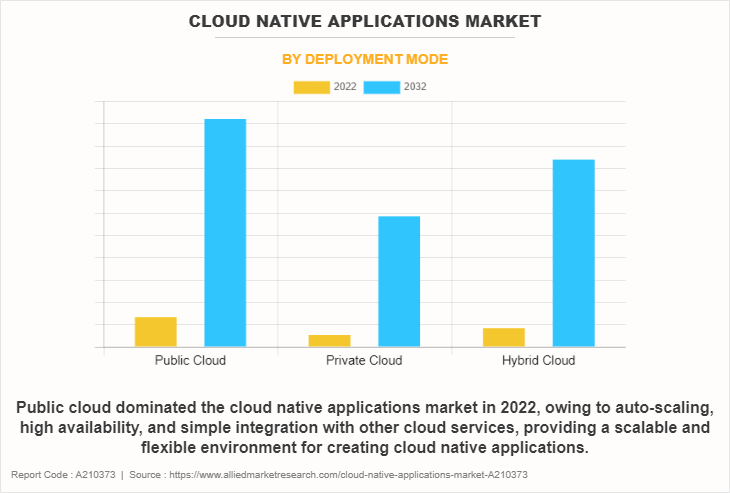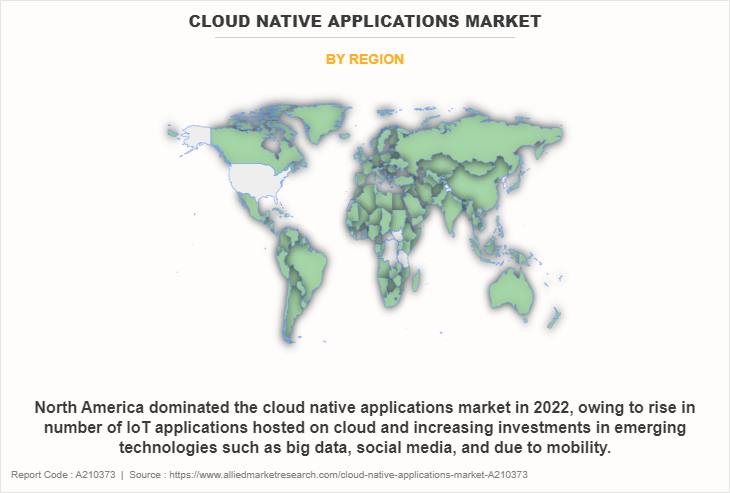Cloud Native Applications Market Insights, 2032
The global cloud native applications market was valued at $5.3 billion in 2022, and is projected to reach $48.8 billion by 2032, growing at a CAGR of 25.2% from 2023 to 2032.
The cloud native applications market focuses on the creation, distribution, and administration of applications that are especially made to run on cloud computing platforms. Applications that are created with cloud-native technologies and principles can fully benefit from the scalability, flexibility, and efficiency provided by the cloud. The capability to be deployed and operated in a distributed manner is one of the primary features of cloud native applications. These applications can be quickly scaled up or down to meet changing demands. They can also be distributed across several cloud servers or data centers to increase performance and reliability.

Moreover, owing to its distributed nature, the cloud platform may easily be integrated with other cloud services and resources, including networking, databases, and storage. In addition, microservices architecture, which includes dividing complicated applications into smaller, loosely linked components, is used by cloud native applications, which makes it even more adaptable. These units, referred to as microservices, can be created and deployed separately, enabling continuous delivery and rapid innovation. As a result of the flexibility to extend or replace individual microservices without affecting the entire application, this modular approach also improves fault tolerance and scalability.
As more businesses recognize the advantages of cloud computing and strive to adopt a more agile and scalable approach to application development, the cloud native application market is expected to expand quickly. There is rise in need for tools, platforms, and services that assist the creation and administration of cloud native applications as cloud platforms and technologies are being adopted more widely. As a result, a thriving ecosystem of vendors and solutions has emerged, offering a vast array of goods and services specifically designed to meet the requirements of developing and operating cloud native applications.
Additionally, rise in adoption of IoT devices and growth in need of data security and privacy, primarily drive the growth of the cloud native application market. However, inconsistency in the IoT standards for compatibility hamper the market growth to some extent. Moreover, rise in adoption of cloud-based devices is expected to provide lucrative opportunities for cloud native applications market forecast.
The cloud native applications market is segmented on the basis of component, deployment mode, enterprise size, end user and region. On the basis of component, it is bifurcated into platform and services. On the basis of deployment mode, it is bifurcated into public cloud, private cloud, and hybrid cloud. On the basis of enterprise size, it is bifurcated into large enterprise and small and medium-sized enterprise. On the basis of end user, it is fragmented into BFSI, IT and telecom, retail and e-commerce, healthcare, government, manufacturing, and others. Region-wise, it is analyzed across North America, Europe, Asia-Pacific, and LAMEA.
The global cloud native applications industry is dominated by key players such as Amazon.com, Inc., Google LLC, IBM Corporation, Infosys Limited, Microsoft Corporation, Oracle Corporation, SAP SE, Red Hat, Inc., VmWare, Inc., and Cognizant. These players have adopted various strategies to increase their market penetration and strengthen their position in the cloud native applications industry.

On the basis of deployment mode, the public cloud segment dominated the cloud native applications market size in 2022 and is expected to maintain its dominance in the upcoming years, as it offers characteristics such as auto-scaling, high availability, and simple integration with other cloud services, providing a scalable and flexible environment for creating cloud native applications, which propels the market growth significantly. However, the private cloud segment is expected to witness the highest growth, owing to the modular and scalable structure of cloud native designs and a greater level of security, due to the isolation and dedication of the infrastructure to a single company.

Region-wise, North America dominated the cloud native applications market share in 2022, owing to rise in number of IoT applications hosted on cloud and increasing investments in emerging technologies such as big data, social media, and due to mobility. However, Asia-Pacific is expected to witness the fastest growth owing to, transformation of IT and telecommunication with the increasing adoption and growth of advanced technology, such as cloud computing, data analytics, AI, and IoT, drives the need for cloud native applications in the Asia-Pacific region.
Top Impacting Factors:
Rising Adoption Cloud Computing
The cloud native app market is primarily driven by the growing popularity of cloud computing. Scalability, flexibility, and cost-effectiveness are few advantages that cloud computing provides, making it a desirable choice for businesses trying to streamline their software development and deployment procedures. Organizations may more effectively create, deploy, and maintain applications due to cloud native applications, which are particularly made to take use of these benefits. Platform-as-a-service (PaaS) and containers are only two of the services that cloud infrastructure vendors provide that make it easier to design and deploy cloud native applications. These services give businesses the frameworks and resources they need to create and deploy cloud-native apps. Cloud platforms are the best choice for hosting cloud native apps owing to their easy scaling up and scaling down, based on demand. Cloud platforms also offer scalability and flexibility.
In addition, cloud offers a dependable and secure environment with built-in redundancy and disaster recovery for hosting applications. This promotes the adoption of cloud native apps by enabling organizations to guarantee the availability and resilience of their applications. The demand for cloud native applications is continually increasing as more businesses realize the advantages of cloud computing and the necessity for scalable and flexible software solutions.
Requirement for Scalable and Agile Software Solutions
Organizations need software solutions that can quickly adapt to shifting market needs and scale up to handle growing workloads in today's fast-paced and competitive business climate. Traditional monolithic apps frequently struggle with flexibility and scalability, which makes it challenging for businesses to successfully adapt to these requirements. Microservices-based cloud native applications address these issues by dividing larger programs into smaller, independently deployable components. Organizations are able to design and deploy apps more quickly owing to this modular strategy. The ability to individually design, test, and deploy each component allows for quicker development cycles and simpler maintenance.
In addition, cloud native applications have the ability to scale particular parts in response to demand, guaranteeing that the application can successfully handle a range of workloads. Organizations can implement and administer cloud native apps using the infrastructure and resources available in the cloud. Scalability, elasticity, and auto-scaling features provided by cloud platforms enable applications to dynamically alter resources in response to demand. As a result, businesses may develop scalability and flexibility needed for their software solutions without spending a fortune on infrastructure or hardware. The demand for cloud native applications increases along with the requirement for flexible and scalable software solutions, which propels the market expansion.
Key Benefits for Stakeholders:
- This report provides a quantitative analysis of the market segments, current trends, estimations, and dynamics of the cloud native applications market analysis from 2022 to 2032 to identify the prevailing cloud native applications market opportunities.
- The market research is offered along with information related to key drivers, restraints, and opportunities.
- Porter's five forces analysis highlights the potency of buyers and suppliers to enable stakeholders make profit-oriented business decisions and strengthen their supplier-buyer network.
- In-depth analysis of the cloud native applications market segmentation assists to determine the prevailing market opportunities.
- Major countries in each region are mapped according to their revenue contribution to the global cloud native applications market growth.
- Market player positioning facilitates benchmarking and provides a clear understanding of the present position of the market players.
- The report includes the analysis of the regional as well as global cloud native applications market trends, key players, market segments, application areas, and market growth strategies.
Cloud Native Applications Market Report Highlights
| Aspects | Details |
| Market Size By 2032 | USD 48.8 billion |
| Growth Rate | CAGR of 25.2% |
| Forecast period | 2022 - 2032 |
| Report Pages | 324 |
| By Component |
|
| By Deployment Mode |
|
| By End User |
|
| By Enterprise Size |
|
| By Region |
|
| Key Market Players | Amazon.com, Inc., SAP SE, Cognizant, Infosys Limited, Microsoft Corporation, VMware, Inc., Oracle Corporation, Google LLC, IBM Corporation, Red Hat, Inc. |
Analyst Review
Due to the rising popularity of cloud computing and the need for scalable and agile software solutions, the market for cloud native application is expanding significantly. Applications that are cloud native are created to take full advantage of cloud infrastructure, enabling businesses to create, deploy, and manage applications more effectively. The necessity for organizations to remain competitive in a quickly changing digital landscape is one of the major factors driving the demand for cloud native applications. Modern businesses expect faster time-to-market, scalability, and resilience, and traditional monolithic apps can no longer match these needs. Organizations can design and deploy applications in a modular and scalable way, utilizing cloud native applications built using microservices architecture, making it simple to react to changing business requirements. In the upcoming years, the demand for digital transformation as well as the growing usage of cloud computing are expected to drive a major increase in the cloud native application market. Platform-as-a-service (PaaS) and containers are only two of the services that cloud infrastructure providers offer, which make it easier to design and deploy cloud native applications. However, to fully benefit from cloud native apps, businesses must address security concerns and transition existing programmers to the cloud native architecture. Despite these obstacles, the cloud native application market is expected to expand as more companies realize the benefits of creating and deploying apps natively in the cloud.?
For instance, in February 2023, Infosys partnered with ng-voice GmbH, a complete containerized and cloud-native IMS solution provider for the telecom market. Under this partnership, both companies worked together for delivering exceptional managed services and cloud-native software solutions while promoting innovation and providing tailored customer experiences to ng-voice clients.
The cloud native applications market was valued at $5,316.84 million in 2022 and is projected to reach $48,777.22 million by 2032, registering a CAGR of 25.2% from 2023 to 2032.
The global cloud native applications industry is dominated by key players such as Amazon.com, Inc., Google LLC, IBM Corporation, Infosys Limited, Microsoft Corporation, Oracle Corporation, SAP SE, Red Hat, Inc., VmWare, Inc., and Cognizant. These players have adopted various strategies to increase their market penetration and strengthen their position in the cloud native application market.
Rise in adoption of cloud-based devices is the leading application of Cloud Native Applications Market
Rise in adoption of IoT devices and growth in need of data security and privacy are the upcoming trends of Cloud Native Applications Market in the world.
Loading Table Of Content...
Loading Research Methodology...


